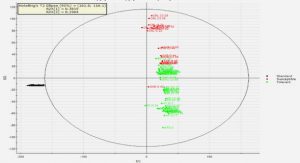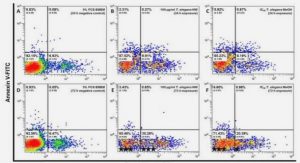Get Complete Project Material File(s) Now! »
Groundwater Monitoring Data
A comparison of selected parameters was performed on the available groundwater monitoring data
for E-Mine. Results of this comparison are described below for each monitoring well.
KRW012 (Figure 20)
Sulfate concentrations in samples from this monitoring well are mostly below 50 mg/L and show a seasonal variability with a rise in concentration starting May of 2012 and increase until the end of the monitoring period. Alkalinity concentrations show a corresponding inverse behaviour with a variable pH throughout the monitoring period. Fe concentrations in this monitoring well are highly variable and range between 2 orders of magnitude.
KRW014 (Figure 21)
pH values in this monitoring well are variable and range between 4 and 7 with a decrease in alkalinity concentrations after mid-2011 and an inversely proportionate increase in sulfate concentrations around this time until the end of the monitoring period. Fe concentrations follow a similar trend to sulfate concentrations in this monitoring well.
KRW024 (Figure 42)
Concentrations of sulfate and alkalinity in this monitoring well are highly variable but generally do not exceed 50 mg/L. Additionally, pH values are variable but generally below 7 with Fe concentrations ranging between 0.01 and 1.
KRW026 (Figure 43)
Sulfate concentrations generally below 100 mg/L can be observed in the monitoring data for this monitoring well with a gradual increase during and after 2012. Alkalinity concentrations remain low for the entire monitoring period with a decrease in pH value during and after 2012. Fe concentrations are highly variable in this monitoring well ranging between 0.01 and 1 for the monitoring period.
KRW027 (Figure 24)
Alkalinity and sulfate concentrations in this monitoring well are generally below 50 mg/L and show a stable trend sulfate and alkalinity concentrations being inversely proportionate. pH values in this monitoring well are generally acidic with a raise in the pH value observed during 2004 and 2008. A
similar trend to sulfate concentrations can be observed in the Fe concentrations in this monitoring
well.
KRW028 (Figure 25)
Slightly acidic pH values are prevalent throughout the monitoring period of this monitoring well with low sulfate concentrations showing some variation and a potential increase after 2013. Alkalinity concentrations throughout the monitoring period are higher than that of sulfate but are much more
variable with a decreasing trend in Fe concentration after 2007.
KRW029 (Figure 26)
Sulfate concentrations in samples from this monitoring well are mostly below 100 mg/L and show a seasonal variability with a rise in concentration starting in 2012 and increase until the end of the monitoring period. Alkalinity concentrations show a corresponding inverse behaviour with a variable pH throughout the monitoring period. Fe concentrations in this monitoring well are highly variable and range between 3 orders of magnitude.
KRW030 (Figure 27)
Slightly acidic pH values are prevalent throughout the monitoring period of this monitoring well showing a general decreasing trend with low sulfate concentrations showing some variation and a potential increase after 2013. Alkalinity concentrations throughout the monitoring period decrease from higher than that of sulfate to lower than that of sulfate after 2006 but are much more variable.
A highly variable Fe concentration can be observed in this monitoring well.
1 Introduction
1.1 Context of the study
1.2 Problem Statement
1.3 Investigation Objectives
2 Literature Review
2.2 Geological Setting of the Study Area
2.2.1 Introduction
2.2.2 Coal Genesis in the Ecca Group
2.2.3 The Vryheid Formation
2.2.4 The Dwyka Group .
2.2.5 Coalfields
2.2.6 The Witbank Coalfield .
2.2.7 The Highveld Coalfield
2.2.8 The Ermelo (Eastern Transvaal) Coalfield
2.2.9 Mineralogy Associated with the Mpumalanga Coal Seams
2.3 Surface Coal Mining in South Africa
2.4 Rehabilitation of Opencast Coal Mines in South Africa
2.4.1 Introduction.
2.4.2 Rehabilitation Methods
2.5 Mine Water
2.6 Mine Water Management
2.6.1 Introduction
2.6.2 Active treatment technologie
2.7 Common Backfill Mineralogy – Vryheid Formation
2.8 Quantification of Mineral Reactive Surface Areas
2.9 Hydraulic Properties of the Karoo Supergroup .
2.9.1 Introduction
2.9.2 Hydraulic Properties of Fractures
2.9.3 Hydraulic Properties of Matrix Blocks
2.10 Influences on the Initial Flush of Rehabilitated Opencast Collieries
2.11 Initial Flush Quantification
3 Description of the Study Sites
3.1 Introduction
3.2 Mine Locations
3.3 Climatic Settings of the Mine
3.4 Hydrological Settings
3.5 Geological Settings of the Mines
3.6 Hydrogeological Settin
3.7 Mining Activities
4 Methodology
4.2 Conceptual Hydrogeological Mode
4.3 Numerical Flow Model Construction
4.4 Conceptual Geochemical Model
4.5 Mineralogical Analysis .
4.6 Reactive Surface Area
4.7 Mineral Reaction Rates
4.8 Acid-Base Accounting .
4.9 Leachate Chemistry .
4.10 Interpretation of Available Groundwater Monitoring Data
4.12 Geochemical System Calibration
4.13 Chemical Calibration of the Numerical Flow Model
4.14 Geochemical Sensitivity Analyses and Implications for Rehabilitation Practices .
4.15 Assumptions and Limitations
5 Results
5.1 C-Mine .
5.2 E-Mine
5.3 A-Mine
6 Synthesis
7 Discussion
8 Conclusions






